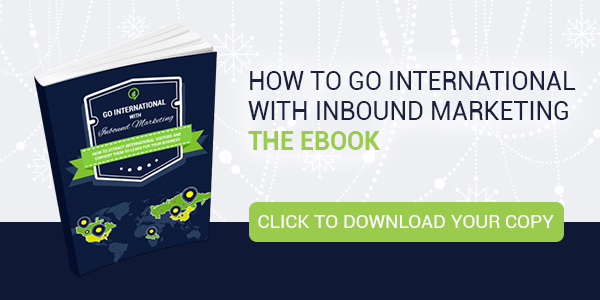Listen to the blog
Entering new markets is always a risky endeavour, but it's meant to pay off in big ways - after all, with scale comes strength and with more volume comes more revenue. That’s if you make it.
We’ve heard tragic tales of company expansion, huge investments in people and machines, cultural conflicts, bouts with lawyers etc. But the opportunities of the internet and the global market place have changed the rules of the game - segmenting nationally is no longer the logical imperative. There are fewer and fewer reasons for businesses not to consider expanding to new markets - or conversely risk being chewed up by aggressive, focused international entrants.
This blog looks at some of the issues companies need to consider before packing up and moving out.
Enter New Markets via the Internet
Funny isn't it. You don't really have to be there physically. These days we can reach out to new customers via the internet and target new markets through Google. Borders disappear as markets are segmented through internet visibility. You no longer need massive outbound marketing investments or voracious local reps, high overhead costs and similar, associated risks.
Inbound marketing (and sales) is the process of attracting the attention of prospects, via content creation, before they are even ready to buy. Whether you’re an established brand looking to grow or you’re considering launching your service into new markets, there are definite benefits to reassessing your traditional marketing playbook.
For Every Successful Market Entry, About 4 Fail
According to McKinsey, for every successful market entry, about four fail. Inexperienced start-ups suffer some of these disappointments, but so do many sophisticated corporations and seasoned entrepreneurs who should know better.
New market entry via the internet - enabled for example through content marketing, Google visibility and marketing automation - can be a) less expensive b) managed largely from home HQ c) easier to exit.

Our new Going International With Inbound E-book outlines the broader, strategic perspective you need to consider like cultural context, technology, etc. in addition to going through the methodology you need to execute . It also looks at the technology aspect with marketing automation software - a prerequisite in this day and age.
Please check it out and remember to share your ideas with us on your challenges and how you view market expansion.
Concentrate on Market Potential & FIT
The first step is pinpointing the most potential market, country or region you want to expand to. Again, how we define a market has changed with the internet.
Your strategy is your choice of customer. By defining buyer personas, you can effectively estimate who you need to target to win and with what content. They will vary with market, and have a dramatic impact on your ability as a service or product to generate traffic and leads - and eventually acquire customers.
Where can you get this information? My first instinct is to reach out via social media. It’s a great way to get insights from your natural contact base. Investing in qualitative and quantitative research is a great idea.
Again - Clear Differentiation and Super Focus
Keep it simple. Consider markets that you have FIT with, make sure they exhibit good growth trends. Coming from a small European market, for example, at Sales Communications we prefer to look at larger markets as long they're not saturated and our value add is evident. Nothing new here, clear differentiation and super focus are also the requisites of digitized expansion.
Ensure the Required Level of Digital Is There
Differentiation brings to mind relevance and timing. Explore markets that understand your offering and in which their digital know how is on a high enough level to fit your sales and marketing approach. Going in early is good, but too early can cost. A good idea is to reach out to potential customers via Linkedin and exchange opinions on market maturity, buying trends, etc.
Ask:- How developed are they digitally?
- Is internet usage high enough?
- What about smartphone penetration?
- Are your buyer personas on the internet?
- How tough is it to reach the top Google rankings in your prospect market?
- How saturated is the thought leadership space?
Where Does Inbound Work?
In my opinion just about everywhere. Some may argue how in specific industries certain buyer personas do not use Google, but if that’s true it’s changing fast. Most open, Western markets are a safe bet - but, for example, if Google is important to your international program, forget Russia – or consider Yandex.
The Internet - A Fair Game?
On the internet, as our prospects look for answers, assess needs and compare alternatives, we all compete on an even footing. Local competitors have the same challenges as you do with content, SEO and SEM. The buying process has become a global standard and our ability to attract visitors to our e-sphere, generate leads and deliver services to clients is less restricted by geography than ever before. From a marketing and sales process vantage point the first steps of the digital marketing and sales funnel are pretty fair game for locals and externals alike.
Consider Cultural Fit
Some cultures get along. A good suggestion is not to stretch that reality too much.
An example: Northern Europe, and I would include the Netherlands, are relatively easy to access if you’re looking at expansion from the (English speaking) US perspective. The level of corruption is low, people tend to be quite pragmatic sales-wise, internet usage and mobile technology are through the roof, and the businesses as well as societies operate by and large according to the same value system.
Embrace Diversity
But even in seemingly similar markets, even if there’s a common language and an apparently similar business culture, you will need to consider the wider picture and embrace diversity in how decisions are made, how the buying cycle works, what they search for on the internet, what the style of sales is and how negotiations are conducted.
Use Local Content Marketing Suppliers
You will need great content to succeed. You can probably utilise some of your existing content, but a word of warning - it’s better to start from scratch and build the materials based on the buyer persona. Why? Because you need to really get under their skin. Be prepared to invest - it can be expensive to generate the needed amount of quality content from top to bottom of funnel. I highly recommend utilising local inbound marketing / content agencies for the job. They can also help you acclimatize your approach accordingly.
Go International With Inbound Marketing!



